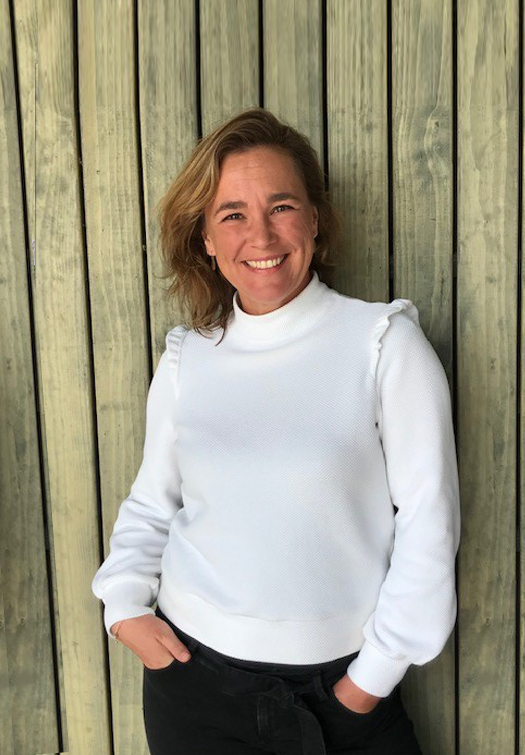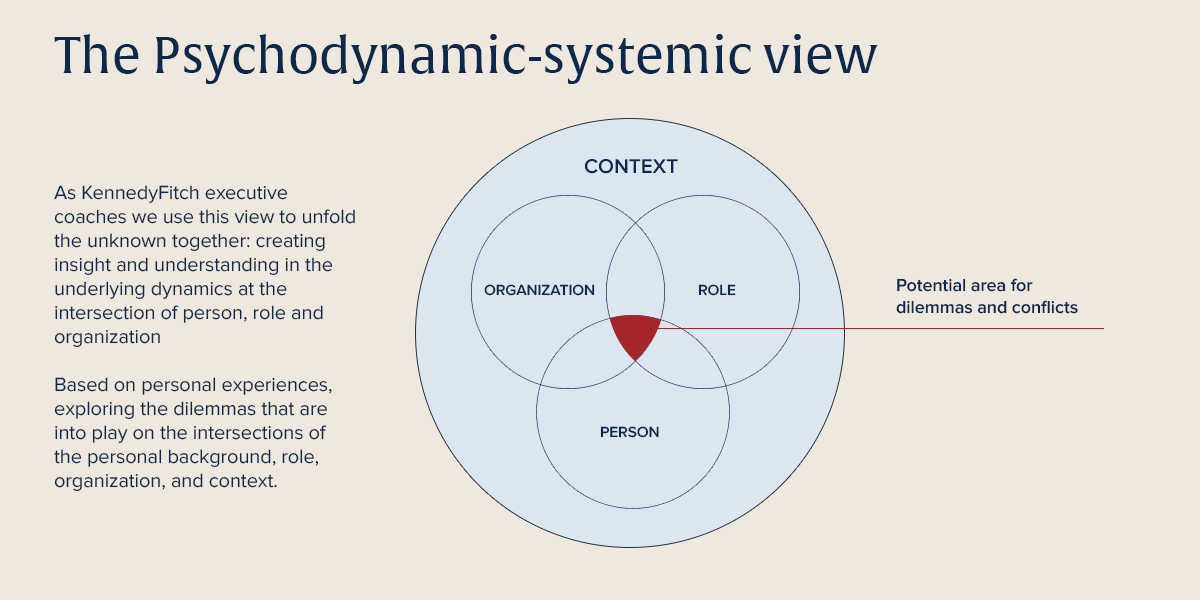The Impact of Psychodynamic Systemic Coaching
We are passionate about empowering individuals, teams, and organizations to excel in their leadership development journey. In our Leadership Development Practice, we do this in a number of ways, including Individual and Team Coaching. Our interventions focus on the key challenges leaders and teams encounter, supporting them to improve their role in team dynamics, navigate conflicts and and maximize their strengths. Our Leadership Development Partners have a variety of coaching backgrounds, allowing us to tap into a wealth of expertise, tools, methods and approaches. In this interview with our partner Tineke van den Heuvel, we will talk about the impact of one of these powerful approaches – psychodynamic systemic coaching.
Through the lens of psychodynamic systemic coaching, we get a holistic understanding of how various factors interact to shape leadership capabilities, a powerful human-centric approach for executives and teams to understand and navigate challenges.

Could you give a more detailed explanation of how psychodynamic systemic coaching impacts personal and professional development in the corporate world?
Absolutely. Psychodynamic systemic coaching is about understanding not just the person but the entire ecosystem. For instance, an executive might struggle with leadership issues not solely because of personal competencies but due to the intersection of their individual psychology, their role in the organization, and the organizational culture.This coaching style helps unravel these complexities. It looks into how a person’s upbringing, values, and habits impact their role and how the organization’s dynamics, in turn, influence them. This holistic perspective is crucial in the corporate setting as it leads to more insightful solutions, enhancing both personal growth and professional effectiveness.

How does psychodynamic systemic coaching differ from more traditional coaching methods in a corporate context?
Traditional coaching often isolates the individual from their environment, focusing mainly on personal skills and goals. Psychodynamic systemic coaching, on the other hand, incorporates a broader perspective. It acknowledges that an individual’s performance and behaviors are significantly influenced by their roles and the dynamics of the organization, including the emotions that come along with the primary task of the organization. For example, a leader’s decision-making style might be affected not just by their personal approach but also by the organization’s values, the team’s dynamics, and even the industry’s norms. This approach is particularly beneficial for senior executives who need to navigate complex, interconnected systems within their organizations.
In your experience, what specific challenges do executives face where psychodynamic systemic coaching proves particularly beneficial?
Many executives encounter challenges that are deeply rooted in the interplay between their personal patterns and the systemic dynamics of their workplace. For instance, an executive might find it challenging to balance assertiveness with empathy, affecting their leadership effectiveness. Through psychodynamic systemic coaching, we can explore how their personal history (like past experiences of success or failure), their current role expectations, and the organizational culture shape this balance. This insight enables them to develop strategies that are not just about changing personal behavior but also about navigating and influencing the organizational environment more effectively. Another common challenge is managing change within the organization. Executives often need to understand not just the logistical aspects of change but also how it impacts them personally, their team, and the broader organizational culture. Psychodynamic systemic coaching helps in mapping out these complex interactions, leading to more effective change management strategies.
Can you share examples of how your coaching has significantly impacted an executive or a team?
Of course. I still remember vividly one of my coachees who struggled with setting boundaries, which was very much needed in the organization he was working at. This was an organization in the public domain, which was being flooded with requests to adhere to, often very unclear and not entirely in line with the primary task of the organization. It was crucial for this leader to set priorities, to dare to say no, in order to protect his team from being totally flooded with work. Consciously this leader knew he had to do this, but somehow, he was being held back. We discovered that in the first organization in which he was active – namely the family he grew up in! – he had been raised with the idea that no request was too crazy. Leading to holidays where they sat with 5 children, a Sint Bernard dog, and a tent on their laps in the car! So far this attitude had, rather unconsciously, helped this leader to be successful, as he had always found ways to get things done, no matter what. However, in the current context, this pattern was a limiting one. The understanding of the fundaments of this pattern, knowing that it came from his warm, happy family background, helped this leader to let go of it in this new situation and to give himself permission to experiment with a more demanding, boundary-setting leadership style in service of his team.
You mentioned that an individual’s performance and behaviors are significantly influenced by the emotions that come along with the primary task of the organization. Can you give an example of this?
An example I often use when I teach about this in a masterclass for organizational psychology students is the following: I once worked with a senior executive who was leading the innovation team which was inventing new techniques to help cure a severe disease. I was approached to support this executive with a coaching process, as the feedback from his team on his leadership style was very negative. He was seen by the team as being way too strict, micromanaging, distant, and even cold. Engagement scores from his team were record-low. Through a process of exploring what was happening in the intersection of person, role, organization and context, we discovered an interesting dynamic.
The pressure of the primary task of the team, working on finding a solution for this disease, was emotionally hard to carry since in their private environment there were so many tangible examples of this disease, and they all felt the immense urge to solve it. As a reaction to these hard-to-carry emotions, they felt frustrated about not being able to get all the money in the world to cure this disease with all the fantastic ideas they had, as the company’s budgets were limited. This meant that many potentially brilliant ideas were not being carried forward. Team members felt hugely frustrated about this, and even felt guilt about having to make choices about which solutions to further explore and which not. However, there was no space where these feelings were openly shared. They were all carried on the inside.
My hypothesis became that, to try to get rid of these feelings of guilt and/or shame, they placed the full responsibility of making these choices on the shoulders of their manager, the senior executive. In other words, they decided the manager was the role to blame and shame, regardless of who was in this role. The executive I was coaching, responded to this, unconsciously, and based on his earlier patterns in life, by installing very strict processes and procedures within the team to ensure he could never be blamed for making a biased, unfair, not well-documented choice. In other words, he was, unconsciously, identifying with the projections being put on him, and as such indeed acted as a micromanaging, distant, rather cold leader. Through our coaching process, we unfolded these dynamics, which gave the executive a choice in how to go about this, and it actually opened up the opportunity to show up as his full self, allowing himself to show his empathetic side much more than before, opening up space to the team to understand the tensions and challenges of their primary task (researching for such a hard disease) and creating co-ownership across the team for the difficult choices which had to be made.

How do you tailor your coaching methods to fit the unique needs of each executive ?
Tailoring my approach to each client is fundamental. For executives, the process always begins with a deep dive into their private and professional history, current challenges, characteristics of their current role and the specific dynamics of their organization. In doing so I often refer to the following:
First, the environment in which we grow up (our family) is actually the first organization in which we are active. In this organization, we learn how to behave and how not: what explicit and implicit values, norms, rules and standards are to which we are held. In later stages of life, especially when we are confronted with new, often exciting, challenges, we tend to go back, unconsciously, to these standards. Raising our awareness of the standards that we have incorporated gives us a choice on how to go about these in the new organizations and contexts we enter in life.
Second, emotions are also data. What we feel says something about ourselves, but also about the roles we are in and the organizations and contexts in which we function. Executive leadership is about becoming fully aware of what happens in this interplay. To be able to go on the balcony, take responsibility for your own behavior in these intersections of person, role, organization, context AND to create space to move forward for those you are leading.
The key is to listen intently, ask probing questions, and use tools and exercises that resonate with the client’s specific context. This approach ensures that the coaching is relevant, impactful, and leads to sustainable change.
Looking ahead, what trends or developments do you foresee in psychodynamic systemic coaching, particularly for senior executives?
The future of psychodynamic systemic coaching, especially for senior executives, is likely to be influenced by several trends. Firstly, as the business world becomes more interconnected and complex, there will be a growing need for coaching that addresses not just individual leadership skills but also how these leaders interact within larger systems — be it their teams, the entire organization, or even external stakeholders.
Additionally, I anticipate a greater emphasis on emotional intelligence and empathy in leadership, driven by a global shift towards more inclusive and diverse workplaces. Psychodynamic systemic coaching will play a crucial role in helping leaders navigate these cultural shifts, ensuring they can lead effectively while fostering an environment of inclusivity and respect.
Another area is the increasing integration of technology in coaching. Digital tools and platforms are likely to become more prevalent, offering new ways to deliver coaching and track progress. However, the core of coaching will remain deeply human-centered on understanding and developing the complex interplay of personal behaviors, relationships, and organizational cultures.
At KennedyFitch, we believe that leadership is not just about reaching personal or organizational goals but about inspiring and influencing others along the way. Through our coaching programs, we aim to not only elevate leadership capabilities but also to enrich the organizational culture and impact. Reach out to us if you would like to learn more about how we can support you in your leadership journey.


